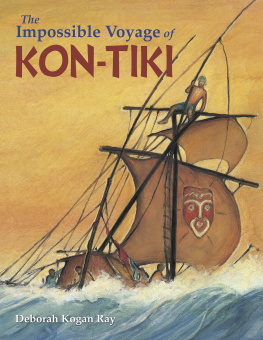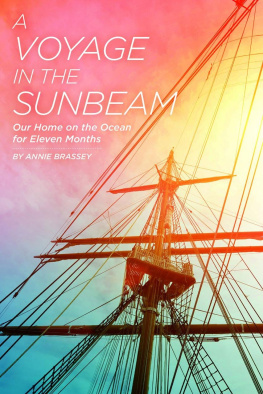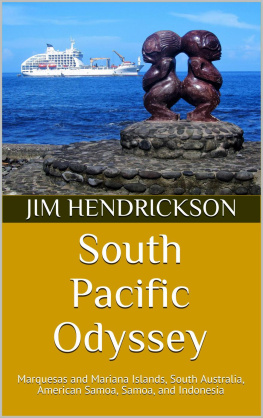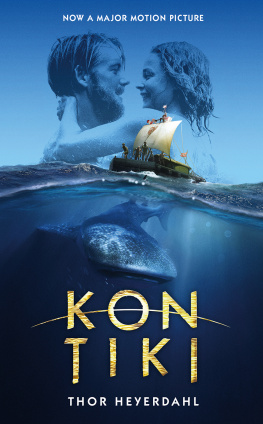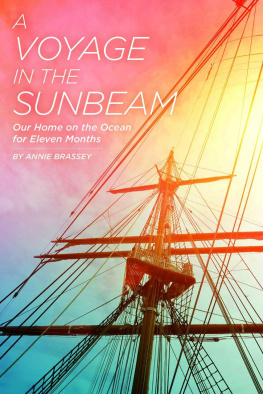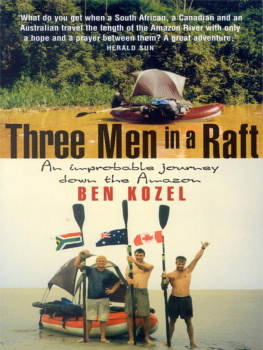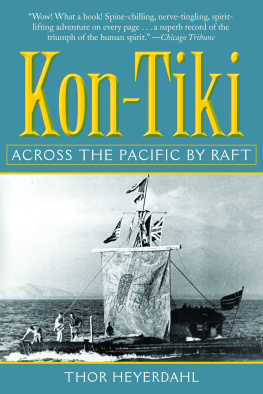
VOYAGE
OF
KON-TIKI
April 25August 7, 1947
101 days
4,300 nautical miles
COLOMBIA
ECUADOR
PERU
Quito
Lima
Panama
Canal
Callao
Marquesas
Islands
Tahiti
Easter Island
Tuamotu
Islands
Equator
Fatu Hiva
Takume
Reef
Puka-Puka
S TART A PRIL 25
M
AY
J
UNE
J
ULY
J
ULY
R AN AGROUND
A UGUST 7
Humboldt Current
Lake
Titicaca
SOUTH
AMERICA
PACIFIC OCEAN
Key
Kon-Tiki voyage
currents
South Equatorial Current
Equatorial Counter Current
Angatau
FRENCH POLYNESIA
Raroia Reef

Deborah Kogan Ray
The
Impossible Voyage of
KON -TI KI
One day my theory was complete. I must go to
America and put it forward.
Thor Heyerdahl, Norwegian anthropologist, 1946

I saw now that no one would accept
my theory.
Impossible! declared the famous professor, shaking his
head at Thor Heyerdahl.
It was not the first time the young Norwegian
anthropologist had received such a response to his research
project. He had arrived in New York City hopeful that
scholars would be open to his theory that ancient Incans
from South America had voyaged by raft to the islands of the
South Pacific. But despite the evidence he presented, his idea
was dismissed as speculation.
Are you willing to try a forty-
three-hundred-mile ocean trip on
a primitive wooden raft to prove
it can be done? asked the
professor, chuckling.

It is my intention to prove that the
journey is feasible.
Thor Heyerdahls theory had been formed on the Polynesian
island of Fatu Hiva, where he had lived for a year with the
native people. The islanders had shown him stone carvings
said to be of the mythic figure Tiki. According to legend,
Tiki brought their ancestors from a land across the sea.
The carvings resembled statues made by ancient
civilizations in South America. Could the two cultures be
related? Thor wondered. Could there be a connection
between the Polynesian Tiki and the Incan god Kon-Tiki
Viracocha? Was it possible that ancient seafarers had crossed
the Pacific Ocean to the South Sea Islands?
After ten years of his research being met with skepticism,
Thor realized what he would have to do.
He decided to build a copy of an Incan balsa-log raft
and reenact the voyage himself.

I believe it will work out; and I am
determined that it shall work out.
Thor spent months assembling the expedition. Impressed
by his zeal, members of New Yorks Explorers Club raised
funds, and the newly formed United Nations assisted with
international clearances to build the raft in Peru. In exchange
for equipment, Thor agreed to test survival gear for the US
Navy. His volunteer crew four Norwegians and a Swede
were seasoned outdoorsmen who looked forward to the
challenge of high-seas adventure.
However, many experienced seamen thought the plan was
reckless, certain the raft would break apart on the open sea.
Nautical engineers warned that the balsa wood would absorb
seawater and sink.
If either contention was right, the voyage would be doomed.

9
The quay was packed with people who
wanted to see the strange craft christened.
The raft was made of nine balsa logs lashed together with
hemp rope. A bamboo cabin behind the single mast would
provide the only shelter. The crew would bring minimal
equipment: a sextant to determine position, shortwave radios
to report their progress, and cameras to film the voyage.
Food supplies were limited because of weight
considerations. Like ancient seafarers, the men would be
dependent on the oceans bounty.
On April 28, 1947, the Kon-Tiki named after the Incan
god along with Thor Heyerdahl and his five-man crew,
was towed out of Callao harbor, near Lima, Peru, and set
adrift in the Humboldt Current.

1110
By late afternoon the trade wind was
already blowing at full strength. It quickly
stirred up the ocean into roaring seas.
Contrary to all warnings, the Kon-Tiki proved to be seaworthy,
and the current carried the raft farther and farther into the ocean.
They were now in the thrall of the powerful westward
trade wind.
There was no turning back.

After a week or so the sea grew calmer.
As the voyagers approached the Equator, a constant
procession of pilot fish and dolphins joined them. At night,
flying fish were attracted by light from the paraffin lamp and
shot onto the deck and into the bamboo cabin sometimes
landing in bed with the men.
The only provisions aboard the raft were coconuts and
dried sweet potatoes, but fresh food was always close at
hand. The men baited lines with small squid and crabs to lure
large tasty tuna and bonitos. They caught sharks by seizing
their tail fins and hauling them on deck.

We saw no sign either of a ship or
drifting remains to show that there were
other people in the world.
The Kon-Tiki existed as its own small world. Thor was
constantly occupied with photographing and recording
the voyages daily activities in the logbook. His boyhood
friend Erik Hesselberg was the only trained seaman aboard

